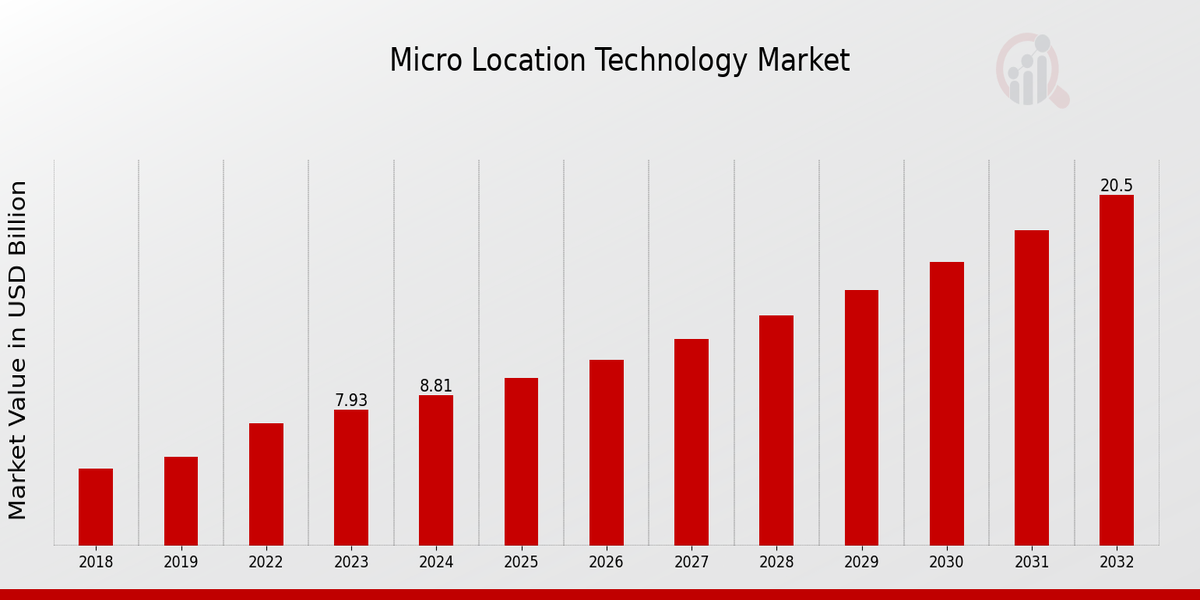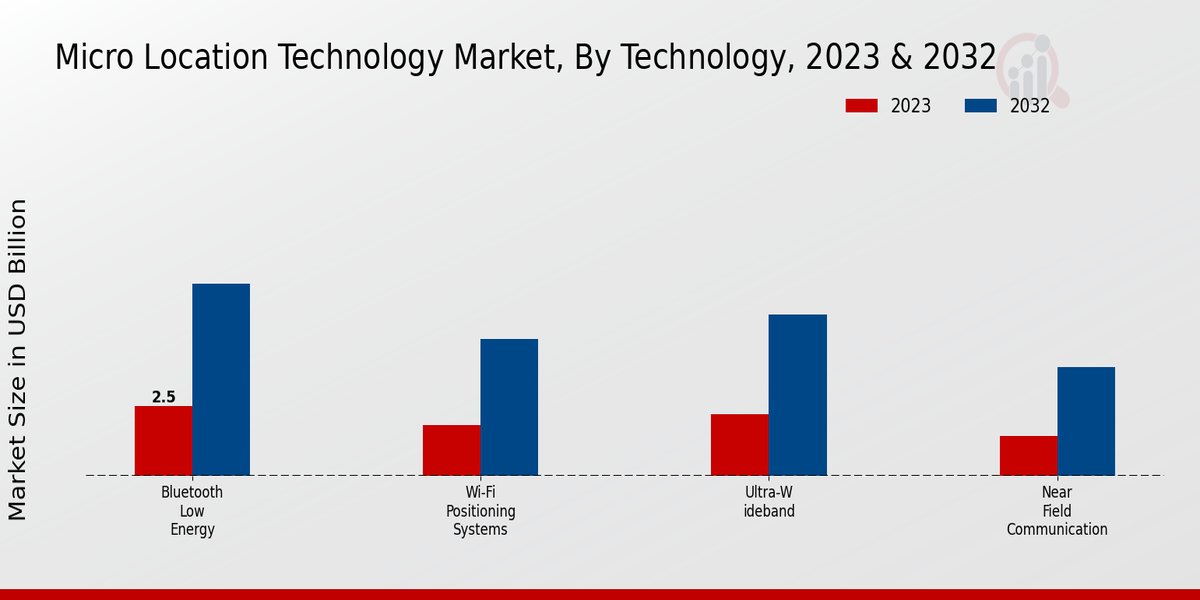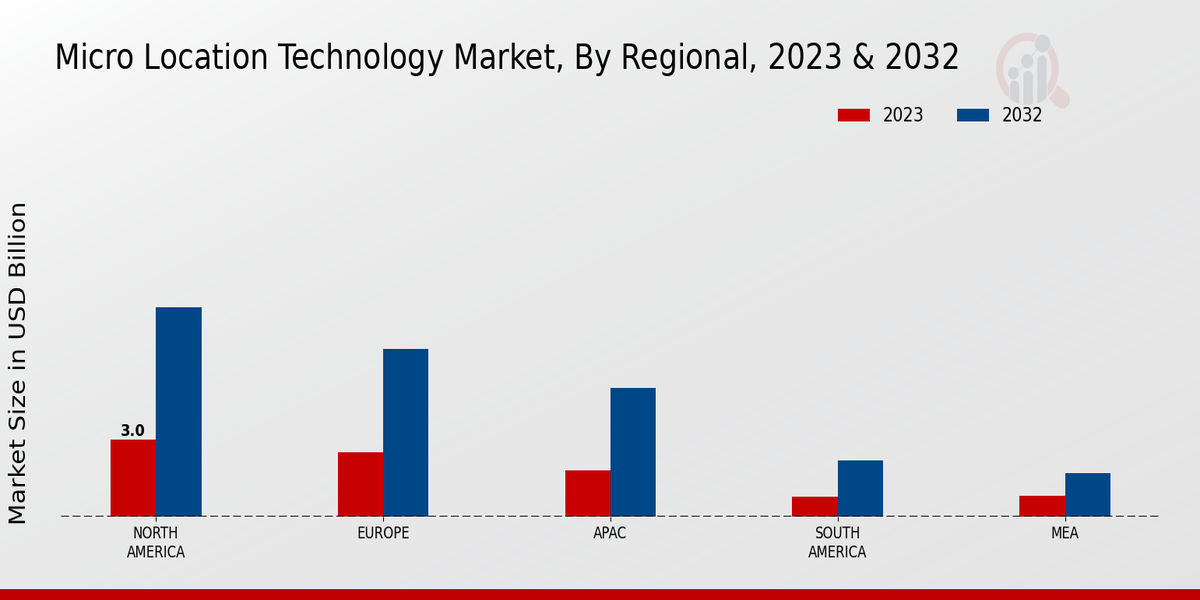Micro Location Technology Market Overview
As per MRFR analysis, the Micro Location Technology Market Size was estimated at 7.14 (USD Billion) in 2022. The Micro Location Technology Market Industry is expected to grow from 7.93(USD Billion) in 2023 to 20.5 (USD Billion) by 2032. The Micro Location Technology Market CAGR (growth rate) is expected to be around 11.13% during the forecast period (2024 - 2032).
Key Micro Location Technology Market Trends Highlighted
The Micro Location Technology Market is expected to witness robust growth. The rising use of various applications, including retail, navigation or asset tracking, and improving location accuracy, is an important aspect that propels the market growth. There is an increasing demand for location-based services among businesses as they aim to improve customer satisfaction and efficiency of their processes. Moreover, the deployment of technology such as Wi-Fi triangulation and Bluetooth low-energy a beacon helps the companies to provide easier and cost-effective micro-location solutions, which increases the growth of the market.
This ongoing trend provides a plethora of opportunities for enterprises to consider. The combination of Micro-location technologies with such advances as augmented reality or the Internet of Things will surely prove as a great source of innovation. Enterprises may examine the prospects of providing tailored solutions for set sectors, for instance, healthcare, manufacturing, or entertainment, where correct location data can be valuable. Furthermore, engaging developing countries where the uptake of location services is at the nascent stage may create new opportunities for revenue generation for firms entering the industry. Nowadays, there is an increased focus on enhancing the personalized experience of consumers as a means of improving engagement.
Organizations are leveraging micro-location technology for data collection on in-store consumers in a bid to enhance marketing techniques and service delivery. Furthermore, the heightened demand for privacy and data protectionism is forcing businesses to adopt better and more ethical approaches to processing location data. With these developments set to progress, participants in the micro-location technology industry will have to be sufficiently flexible to adjust to shifting consumer and legal jurisdictions.
Figure 1: Micro Location Technology Market Size, 2025-2034 (USD Billion)

Source: Primary Research, Secondary Research, MRFR Database and Analyst Review
Micro Location Technology Market Drivers
Rising Demand for Enhanced Location-Based Services
The Micro Location Technology Market Industry is experiencing significant growth driven by the increasing demand for advanced location-based services across various sectors. Businesses and organizations are increasingly recognizing the potential of micro-location technologies to enhance customer experiences and improve operational efficiencies.
This shift is particularly evident in retail, hospitality, healthcare, and logistics, where precise location data can enable personalized marketing, efficient asset tracking, and improved customer service. The explosion of mobile device usage and the proliferation of data-driven decision-making have also contributed to this trend. As companies seek to leverage real-time location insights, they are adopting micro-location technologies that utilize indoor positioning systems, Bluetooth beacons, and Wi-Fi triangulation to gather contextually relevant data.
Furthermore, this growing emphasis on location accuracy is leading to innovations and advancements in the technology itself, making it more accessible and effective in various applications.Industries are now able to gather granular data about user behaviors, preferences, and movement patterns, which in turn fosters targeted engagement strategies and drives revenue growth. As more organizations invest in these technologies to create competitive advantages, this rising demand is set to propel the Micro Location Technology Market Industry forward.
Growing Adoption of IoT and Smart Devices
The growing adoption of Internet of Things (IoT) devices and smart technologies is a crucial driver of the Micro Location Technology Market Industry. With the expansion of IoT ecosystems, interconnected devices are generating vast amounts of data, and accurate location tracking has become paramount for analyzing and optimizing interactions between these devices. Micro location technologies play a vital role in enhancing the capabilities of IoT devices by enabling low-latency location tracking essential for applications such as asset management, smart transportation, and smart city initiatives.
The synergy between IoT and micro-location technology fosters smarter solutions and promotes increased efficiency across various sectors. Businesses harness this integration to develop innovative applications that facilitate real-time monitoring and control of assets, thus driving growth in the market.
Increased Investment in Smart Infrastructure
The increasing investment in smart city infrastructure is another significant driver for the Micro Location Technology Market Industry. Governments and urban planners are recognizing the importance of developing intelligent infrastructure that enhances city management and urban living.
The implementation of micro-location solutions allows for improved traffic management, public safety, infrastructure monitoring, and urban planning. Smart infrastructure initiatives leverage location technology to optimize resource allocation and create responsive urban environments that adapt to the needs of residents and businesses.Furthermore, as cities continue to integrate digital technologies, the demand for micro-location solutions is expected to rise, ensuring sustained growth in the industry.
Micro Location Technology Market Segment Insights
Micro Location Technology Market Technology Insights
The Micro Location Technology Market is evolving significantly, particularly within the Technology segment, which encompasses crucial communication protocols and positioning systems. In 2023, the overall market was recorded at 7.93 USD Billion, with particular sub-segments contributing notably to the total valuation. Bluetooth Low Energy is highlighted as a major player, holding approximately 2.5 USD Billion this year and projected to rise to 6.9 USD Billion by 2032, showcasing its robustness and widespread applicability in various sectors like retail and healthcare for location-based services.
Wi-Fi Positioning Systems followed, bringing in 1.8 USD Billion, with expectations to expand to 4.9 USD Billion by the end of the forecast period, driven by the increasing demand for accurate indoor positioning and navigation solutions. Ultra-Wideband, valued at 2.2 USD Billion in 2023, is also gaining traction, with a future valuation of 5.8 USD Billion anticipated due to its high precision and low power consumption, making it ideal for asset tracking solutions. Lastly, Near Field Communication, while smaller, at 1.43 USD Billion, is still significant and expected to grow to 3.9 USD Billion.
The shift towards automated and real-time tracking methods provides substantial growth opportunities in the Micro Location Technology Market. Emerging technologies, coupled with the growing emphasis on digital transformation, are positioning these technologies to meet future demands. However, challenges such as regulatory concerns and cost implications may impact market dynamics. Overall, the market shows a promising trajectory, driven by innovation and a growing array of applications across industry verticals.

Source: Primary Research, Secondary Research, MRFR Database and Analyst Review
Micro Location Technology Market Application Insights
The Application segment of the Micro Location Technology Market is a vital area, expected to contribute significantly to the overall market value of 7.93 USD Billion in 2023 and is projected to grow steadily in the coming years. This segment encompasses various fields, including Retail, Hospitality, Healthcare, and Transport and Logistics, each playing an important role in driving market growth.
The Retail sector, for instance, utilizes micro-location technology to enhance customer experiences through personalized marketing and efficient inventory management, ensuring it remains a significant player within the market.In Hospitality, this technology streamlines operations and improves guest experiences, while in Healthcare, it enables real-time tracking of assets and personnel, thereby improving overall efficiency and patient care.
The Transport and Logistics sector benefits from micro-location technology by optimizing supply chain operations and enhancing tracking capabilities. With growing demand for precision and efficiency in these applications, the Micro Location Technology Market segmentation reflects the industry's adaptability to emerging trends, driven by the need for real-time data and improved operational processes across these diverse sectors.
Micro Location Technology Market End-Use Insights
The Micro Location Technology Market, valued at 7.93 USD Billion in 2023, showcases a robust segmentation around end-use applications, with significant engagement from various sectors. Consumer electronics has established a substantial presence, as smart devices increasingly rely on micro-location technology for enhanced user experience.
Meanwhile, the smartphone sector dominates this space owing to the integration of location-based services that cater to consumer demands for navigation and personalization. Wearable devices demonstrate promising growth trends within this market as they leverage micro-location technology for health monitoring and fitness tracking, fulfilling the rising consumer interest in health and wellness.IoT devices also play a crucial role, with the widespread adoption of smart homes and connected devices driving the need for precise location tracking.
As these segments continue to evolve, they collectively contribute to the increasing Micro Location Technology Market revenue and statistics, reflecting the demand for precise and efficient location-based services across multiple industries. The interplay of technology advancements and consumer requirements fuels market growth and dynamism, presenting numerous opportunities for stakeholders in the rapidly advancing micro-location technology landscape.
Micro Location Technology Market Deployment Type Insights
The Micro Location Technology Market segmented by Deployment Type showcases a diverse landscape that responds to varying business needs. In 2023, the market is valued at 7.93 USD billion, reflecting the growing adoption of micro-location solutions that enhance navigation and tracking capabilities.
The Deployment Type primarily comprises On-premises and Cloud-based solutions, each offering distinct advantages. On-premises deployment is often favored by organizations requiring enhanced control over their data and infrastructure, making it a significant choice, especially in sectors that prioritize data security.Meanwhile, Cloud-based solutions are gaining traction due to their scalability and flexibility, allowing businesses of all sizes to access advanced services without the need for extensive physical infrastructure.
This trend is part of a broader shift towards digital transformation, fueled by the need for real-time information, improved customer experiences, and operational efficiency. The combination of both deployment types presents numerous opportunities for organizations looking to leverage micro-location technologies, contributing to the overall market growth as reflected in the forecasted figures for the coming years.The competition within these deployment categories offers insights into consumer preferences, shaping the future trajectory of the Micro Location Technology Market.
Micro Location Technology Market Regional Insights
The Micro Location Technology Market demonstrates varying levels of engagement across its regional segments, with North America leading the market with a valuation of 3.0 USD Billion in 2023 and projected to reach 8.1 USD Billion by 2032. This significant market share reflects the region's robust technological infrastructure and early adoption of micro-location solutions. Europe closely follows with a 2023 valuation of 2.5 USD Billion, expected to grow to 6.5 USD Billion by 2032, driven by rising demand for location-based services in retail and transportation sectors.
The Asia-Pacific (APAC) region shows strong growth potential, currently valued at 1.8 USD Billion and anticipated to reach 5.0 USD Billion, driven by increasing smartphone penetration and the expansion of IoT devices. South America and the Middle East Africa (MEA) regions are smaller in comparison, valued at 0.8 USD Billion and 0.83 USD Billion in 2023, with expectations to grow to 2.2 USD Billion and 1.7 USD Billion, respectively, by 2032. Despite their lower market sizes, these regions present opportunities for growth as they improve their technological capabilities and infrastructure.Overall, the Micro Location Technology Market revenue reflects significant diversification and gradual expansion across these regional markets.

Source: Primary Research, Secondary Research, MRFR Database and Analyst Review
Micro Location Technology Market Key Players and Competitive Insights
The Micro Location Technology Market is experiencing robust growth owing to the increasing demand for precise location-based services across various sectors, including retail, transportation, and navigation. Companies are seeking to enhance user experiences by providing accurate indoor positioning solutions that facilitate better engagement and operational efficiencies. The competitive landscape is characterized by a diverse range of players offering innovative technologies such as Bluetooth, Wi-Fi, and GPS alternatives to cater to evolving consumer needs.
As businesses prioritize real-time data analytics, integration with IoT devices becomes crucial, creating opportunities for advancement and differentiation. Additionally, the market is witnessing strategic partnerships, mergers, and acquisitions as organizations aim to strengthen their technological capabilities and expand their market presence. Ultimately, the competitive dynamics within the micro-location technology segment drive continuous evolution as companies strive to outperform one another through localization strategies and better service delivery.
IndoorAtlas stands out in the Micro Location Technology Market due to its proprietary technology that leverages the Earth's magnetic field for precise indoor positioning. This innovative approach allows IndoorAtlas to offer highly reliable location data without the reliance on GPS, which often falters in urban environments. With a robust presence in many industries, IndoorAtlas has effectively carved a niche by enabling businesses to create immersive user experiences through contextually relevant location services. Their indoor mapping solutions are not only easy to implement but also highly scalable, making them ideal for enterprises seeking a seamless integration of location services within their existing frameworks.
The company's commitment to continuous development and staying ahead of technological trends affirms its strength within the highly competitive micro-location landscape, as it delivers value across various applications like navigation, asset tracking, and customer engagement.Samsung, a notable player in the Micro Location Technology Market, brings an immense brand reputation and extensive resources to the forefront of this sector.
By developing advanced location-based solutions integrated with their existing hardware and software, Samsung offers a seamless experience that appeals to both consumers and businesses. The company's research and development efforts in enhancing connectivity and positioning technologies allow for greater accuracy and reliability in indoor environments. Samsung's formidable presence in the technology sector enables it to leverage its wide range of existing devices, from smartphones to smart home solutions, providing comprehensive micro-location services that cater to diverse market needs.
Their strategic collaborations and focus on innovation not only bolster their competitive edge but also amplify the overall adoption of micro-location technology across multiple industries, highlighting their importance in shaping the future of this market segment.
Key Companies in the Micro Location Technology Market Include
- IndoorAtlas
- Samsung
- Zebra Technologies
- Navisens
- Apple
- Resilience
- Wayfindr
- Mapsted
- Locatify
- Sonosight
- Senion
- Estimote
- Google
- HERE Technologies
- Cisco
Micro Location Technology Market Industry Developments
The Micro Location Technology Market has recently seen significant developments. IndoorAtlas has enhanced its indoor positioning technology, providing retailers with precise tracking capabilities to improve customer experiences. Samsung is also advancing its solutions, focusing on integrating micro-location features within smart devices. Zebra Technologies has reported growth, with its asset visibility solutions gaining traction in the logistics sector.
Navisens has been making strides in sensor-based navigation, while Apple continues to expand its AR capabilities, impacting location services. Estimote has introduced new beacon technology to improve retail engagement, and HERE Technologies is advancing its mapping services to include micro-location functionalities. Merger and acquisition activities have been apparent, with Cisco acquiring a startup that focuses on location analytics, marking a significant move in the sector.
The continuous growth of these companies is positively impacting market valuation, reflecting a higher demand for precise location-based services. Organizations are leveraging advanced technology to enhance user interaction and operational efficiency, particularly in retail and logistics, as the industry moves towards more connected and intelligent environments. This evolution signifies an optimistic trajectory for stakeholders in the micro-location technology landscape.
Micro Location Technology Market Segmentation Insights
-
Micro Location Technology Market Technology Outlook
- Bluetooth Low Energy
- Wi-Fi Positioning Systems
- Ultra-Wideband
- Near Field Communication
-
Micro Location Technology Market Application Outlook
- Retail
- Hospitality
- Healthcare
- Transport and Logistics
-
Micro Location Technology Market End-Use Outlook
- Consumer Electronics
- Smartphones
- Wearable Devices
- IoT Devices
-
Micro Location Technology Market Deployment Type Outlook
-
Micro Location Technology Market Regional Outlook
-
North America
-
Europe
-
South America
-
Asia-Pacific
-
Middle East and Africa
| Report Attribute/Metric |
Details |
| Market Size 2022 |
7.14(USD Billion) |
| Market Size 2023 |
7.93(USD Billion) |
| Market Size 2032 |
20.5(USD Billion) |
| Compound Annual Growth Rate (CAGR) |
11.13% (2024 - 2032) |
| Report Coverage |
Revenue Forecast, Competitive Landscape, Growth Factors, and Trends |
| Base Year |
2023 |
| Market Forecast Period |
2024 - 2032 |
| Historical Data |
2019 - 2022 |
| Market Forecast Units |
USD Billion |
| Key Companies Profiled |
IndoorAtlas, Samsung, Zebra Technologies, Navisens, Apple, Resilience, Wayfindr, Mapsted, Locatify, Sonosight, Senion, Estimote, Google, HERE Technologies, Cisco |
| Segments Covered |
Technology, Application, End Use, Deployment Type, Regional |
| Key Market Opportunities |
Indoor navigation solutions, Retail analytics enhancement, Proximity marketing capabilities, Smart building automation, Enhanced customer experience tools |
| Key Market Dynamics |
Increased demand for location accuracy, Growth of IoT devices, Expanding retail applications, Advancements in positioning technologies, Rising adoption of AR/VR solutions |
| Countries Covered |
North America, Europe, APAC, South America, MEA |
Frequently Asked Questions (FAQ) :
The Micro Location Technology Market is expected to be valued at 20.5 USD Billion by the year 2032.
The expected CAGR for the Micro Location Technology Market from 2024 to 2032 is 11.13%.
North America is projected to have the largest market value, expected to reach 8.1 USD Billion by 2032.
Bluetooth Low Energy technology is expected to reach a market value of 6.9 USD Billion by 2032.
Key players in the market include IndoorAtlas, Samsung, Zebra Technologies, Apple, and Google.
The market for Wi-Fi Positioning Systems is anticipated to reach 4.9 USD Billion by 2032.
The Near Field Communication segment is projected to grow to 3.9 USD Billion by the year 2032.
The Asia-Pacific region is expected to reach a market value of 5.0 USD Billion by 2032.
Major growth drivers include the rising demand for real-time location services and advancements in location-based technologies.
The Ultra-Wideband technology market is expected to be valued at 5.8 USD Billion by the year 2032.

















